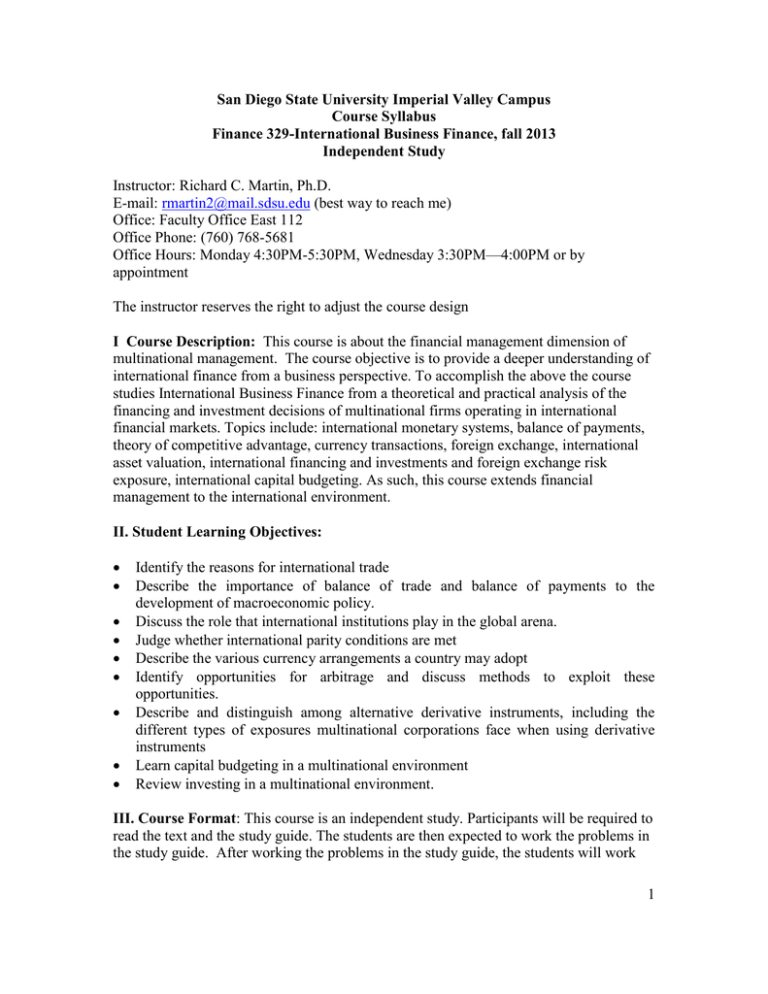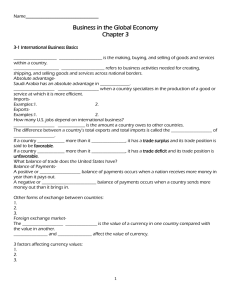
San Diego State University Imperial Valley Campus
Course Syllabus
Finance 329-International Business Finance, fall 2013
Independent Study
Instructor: Richard C. Martin, Ph.D.
E-mail: rmartin2@mail.sdsu.edu (best way to reach me)
Office: Faculty Office East 112
Office Phone: (760) 768-5681
Office Hours: Monday 4:30PM-5:30PM, Wednesday 3:30PM—4:00PM or by
appointment
The instructor reserves the right to adjust the course design
I Course Description: This course is about the financial management dimension of
multinational management. The course objective is to provide a deeper understanding of
international finance from a business perspective. To accomplish the above the course
studies International Business Finance from a theoretical and practical analysis of the
financing and investment decisions of multinational firms operating in international
financial markets. Topics include: international monetary systems, balance of payments,
theory of competitive advantage, currency transactions, foreign exchange, international
asset valuation, international financing and investments and foreign exchange risk
exposure, international capital budgeting. As such, this course extends financial
management to the international environment.
II. Student Learning Objectives:
Identify the reasons for international trade
Describe the importance of balance of trade and balance of payments to the
development of macroeconomic policy.
Discuss the role that international institutions play in the global arena.
Judge whether international parity conditions are met
Describe the various currency arrangements a country may adopt
Identify opportunities for arbitrage and discuss methods to exploit these
opportunities.
Describe and distinguish among alternative derivative instruments, including the
different types of exposures multinational corporations face when using derivative
instruments
Learn capital budgeting in a multinational environment
Review investing in a multinational environment.
III. Course Format: This course is an independent study. Participants will be required to
read the text and the study guide. The students are then expected to work the problems in
the study guide. After working the problems in the study guide, the students will work
1
the assigned problems from the text. After these activities students will be required to email to the instructor a list of questions which will be answered in a face to face meeting.
IV. Evaluation
Participant performance will be assessed on examinations and a Foreign Currency
Report.
V. Prerequisites:
Finance 323 Fundamentals of Finance
Approved upper division business major, business minor, or another major
approved by the College of Business Administration
General understanding of algebra and economics is desirable.
In addition, since this course cuts across all major finance topic areas, a strong
background in domestic corporate finance and investment is desirable.
General background in international business/monetary environments is useful but
not necessary.
VI. Course Requirements:
1. Textbook:
a. Moffett, Michael; Stonehill, Arthur; Eiteman, David; Multinational
Finance, 3rd Edition, 2009, Pearson Prentice-Hall, Inc., N.J
b. Study Guide: for the above text.
2. Examinations: There will be four exams during the semester. The exams may
include short answer questions, essays and problems. The exams are not cumulative and
will cover only the material contained for the weeks specified prior to the exam.
3. Report on Foreign Currency: Participants will choose a foreign currency to follow.
No two participants can follow the same currency. Staring on Oct. 21 every participant
will start following the changes in their chosen foreign currency. Each participant will
keep a log with an entry every Monday starting Oct. 21 with the value of the currency
compared to the U.S. dollar. Starting on Oct. 28 the log will state the value of the
currency and the amount that currency increased or decreased in relation to the U.S.
dollar. In addition, the log should show in U.S. dollars and in the foreign currency
amount the value of a U.S. $100,000 investment made on Oct. 21. The participants
should review the news to see if they can find reasons for the change in the value of the
currency. Log entries will be made until Dec. 2. Participants should be prepared to
discuss the changes in the currency they follow. Please post to blackboard turnitin
assignments by Dec. 10 a three to four page report that contains the following.
A. A one-page executive summary on what you learned from following the
currency.
B. The log showing the value of the currency each week, the percentage change in
the currency, and the value of the $100,000 investment made on Oct. 21
2
C. A summary of the major fluctuations in the currency for the past 20 years.
D. Suggested format of table
Date
Amount of
Foreign
Currency
10/21
10/28
To be calculated
Same as 10/21
$100,000
To be
calculated
10/28
Same as 10/21
To be
calculated
To be calculated
Monday
Till 12/2
Entries To log made
Exchange Amount in
Rate
U.S.
Dollars
Every
Percentage
increase or
decrease to U.S.
Dollar
N/A
To be calculated
Possible
reasons for
change
N/A
To be filled in
if relevant
information
To be filled in
if relevant
information
Papers handed in late carry a 10-point penalty for each 24 hour period. The maximum
possible late penalty is 50 points off the earned grade
.
4. Evaluation Criteria:
1st Exam
2nd Exam
3rd Exam
4th exam
Foreign Currency Report
20%
20%
20%
20%
20%
5. Grading Criteria:
A = 100-94; A- = 93-90; B+ = 89-87; B = 86-83; B- = 82-80; C+ = 79-77, C=76-73, C=72-70, D+=69-67, D=66-63, D-+62-60, below 60=F
A grade of “WU” for a “withdrawal unauthorized” (formally “U”) indicates that you
enrolled in a course, did not officially withdraw from the course, but failed to complete
course requirements. For purposes of GPA computation, this grade is equivalent to an
“F”. If you attend a portion of a course and then, after receiving a failing grade, stop
attending without officially withdrawing, you will receive a final grade of “F” rather than
“WU”
A grade of “I” for “incomplete authorized” is only given when a minor portion of
required course work has not been completed and evaluated in the prescribe time period
due to unforeseen, but fully justified, reasons. An incomplete shall not be assigned when
the only way you could make up the work would be to attend a major portion of the class
when it is offered next.
3
I will have discretion for adjusting the course grade by one grade category, (e.g. from D+
to C- or D)/ I do not normally use this discretion; however, have used it to raise a
participant to a C- or D.
VII. Schedule:
Week of:
Topic and Assignment
Aug. 26
Moffett Ch. 1: Globalization and creating value, theory of competitive
advantage, what is global financial management
.Assignments:
A. Questions 2, 4, 6, 7, 8, 9
B. Problem 6
Sept. 2
Moffett Ch. 3: International Monetary System, the Eurocurrency market,
currency regime choices
Assignments:
A. Questions 4, 5, 6, 8, 9, 10, 12, 14
B Problems 2,7,13
Sept. 9
Moffett Ch. 4: Measure of international economic activity and balance of
payments, affect on trade balances of exchange rate changes and volatility,
history of capital mobility and capital flight
Assignments:
A. Questions 1, 2, 3, 5, 6, 8, 10, 13, 14, 15
B. Problem 1
Sept. 16
1st Exam
Sept. 23
Moffett Ch. 17: Foreign Direct Investment Theory & Strategy, sustaining
competitive advantage, the OLI paradigm, deciding where to invest,
modes of involvement
A. Questions 4, 6, 8, 10, 11, 12, 13, 14
Sept. 30
Moffett Ch. 5: Currency trading in global market, types of foreign
exchange financial instruments, currency quotation, intermarket arbitrage
Assignments:
A. Questions 1, 2, 4, 6, 7, 9
B. Problems 1, 2
Oct. 7
Moffett Ch. 6: Inflationary affects on exchange rate, interest rates, forward
currencies and market expectations,
Assignments:
A. Questions 1, 3, 5, 7, 8, 9, 10
4
B. Problems 6,10,15
Oct. 14
Second Exam
Oct. 21
Moffett Ch. 7: Examine concept of supply and demand for currency,
explore approaches to exchange rate determination, and review history of
currency crises, technical and theoretical approaches to forecasting
Assignments:
A. Questions 4, 5, 7, 10, 11, 12, 13
B. Problems 2,5
C. Begin work on foreign currency report
Oct. 28
Moffett Ch. 8: Examine foreign currency futures, forward contracts,
options
A. Questions 1, 5, 6, 7, 9, 10
Nov. 4
Third Exam
Nov. 11
Moffett Ch. 9: Types of transaction foreign exchange, exposure, foreign
exchange risk management, and hedging foreign exchange exposure,
alternatives for managing transaction exposure
Assignments:
A. Questions 2, 4, 5, 8, 10
B. Problem 8
Nov. 18
Moffett Ch. 11: Translation practices and foreign exchange exposure,
foreign subsidiary’s functional currency, converting foreign currency
denominated financial statements
A. Questions, 1, 2, 3, 4, 5, 7, 10, 11
B. Problems and cases to be assigned
Nov. 25
Thanksgiving week no assignment
Dec. 2
4th Exam
Dec. 10
Foreign Currency Report Due
5







